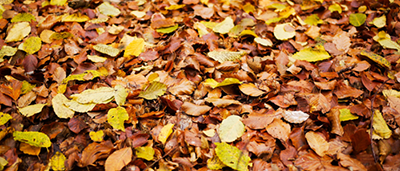
Autumn leaves (c) Håkan Dahlström
As the last maples drop their leaves and frost arrives, the fall clean-up begins. Those with lawns rake, blow, bag, and drag to create the tidy, bare winter landscape we’ve been taught to equate with “good gardening.”
Kazys Varnelis, President of the Native Plant Society of New Jersey, argues that the practice of stripping our yards down to the soil is ecologically harmful, and only recently became the norm. The habit was born of gas-powered leaf blowers and post-war suburbia’s focus on neat lawns. “It’s not normal to have a landscape without leaves in the fall – the season is literally named for them,” Varnelis notes. “Bare, scraped-clean yards aren’t natural. And frankly, they’re not beautiful. A garden full of colorful leaves, seed heads, and winter structure is far more interesting.”
 Many pollinators and other beneficial insects survive winter’s cold by sheltering under leaf litter, either as adults, eggs, nymphs, larvae, or cocoons. Species that pollinate crops, eat pests, and fuel entire food webs all rely on a soft, insulating layer of moist fallen leaves to survive winter.
Many pollinators and other beneficial insects survive winter’s cold by sheltering under leaf litter, either as adults, eggs, nymphs, larvae, or cocoons. Species that pollinate crops, eat pests, and fuel entire food webs all rely on a soft, insulating layer of moist fallen leaves to survive winter.
Scientists have documented steep declines in insects across the globe in what some are calling an “insect apocalypse.” Varnelis sees the signs: “I’m in my fifties, and I can vividly remember long drives where the windshield was covered in insects. Now it’s spotless. That should terrify us. Insects have been here for hundreds of millions of years.”
It’s not just about leaves. Seed heads and stems that remain through the winter support a wide range of wildlife. Many native bees nest in hollow or pithy stems of plants like elderberry, sumac, and goldenrod. Birds forage on seed heads all winter long. “We love our feeder birds, but feeders train birds to depend on us. Native seed heads are what they’ve evolved with,” Varnelis says. “Leaving them standing through winter is one of the easiest ways to support bird populations.”
Even fallen sticks play a role. Branches help activate the fungal networks in soil, allowing trees and native plants to absorb nutrients and withstand drought. “There’s nothing better you can do for your soil than leave the leaves and the sticks,” Varnelis emphasizes.
 The obstacles, he says, are aesthetics and grassy lawns. Thick layers of leaves can lead to brown patches on lawns, and people have been conditioned to see tidy, barren yards as attractive. But leading landscape designers around the world are moving toward naturalistic design, which celebrates winter texture, structure, and seasonality rather than erasing it. “People say leaves and seed heads look messy but compared to what?” he says. “We just need to recalibrate our sense of what a healthy landscape looks like.”
The obstacles, he says, are aesthetics and grassy lawns. Thick layers of leaves can lead to brown patches on lawns, and people have been conditioned to see tidy, barren yards as attractive. But leading landscape designers around the world are moving toward naturalistic design, which celebrates winter texture, structure, and seasonality rather than erasing it. “People say leaves and seed heads look messy but compared to what?” he says. “We just need to recalibrate our sense of what a healthy landscape looks like.”
Roofs, gutters, and paved driveways will always need clearing. Yet even landscapers motivated to keep lawns green and vibrant can redistribute fallen leaves into garden beds and add natural, nutrient-rich mulch into the environment. Don’t make the mistake of heaping mulch or leaves up against tree trunks in your yard, as their roots need to breathe! Keeping a contained leaf mulch composting area can be a practical solution for storing excess leaves while they decompose into useful organic humus.
We can all stop exporting our leaves to the curb and start using them to enrich soil, support our wild neighbors, and restore our yards. And if we can adjust our idea of an attractive lawn to align with the eyes of Mother Nature, we’ll see a beautiful winter garden when we look outside.
Visit https://npsnj.org/ to learn more about New Jersey’s native plants, and visit https://www.jerseyyards.org/create-a-jersey-friendly-yard/ to learn about building an environmentally friendly yard.
To learn more about how you can help preserve New Jersey’s natural resources, visit the New Jersey Conservation Foundation at www.njconservation.org or reach out to us at info@njconservation.org.

Comments are closed.